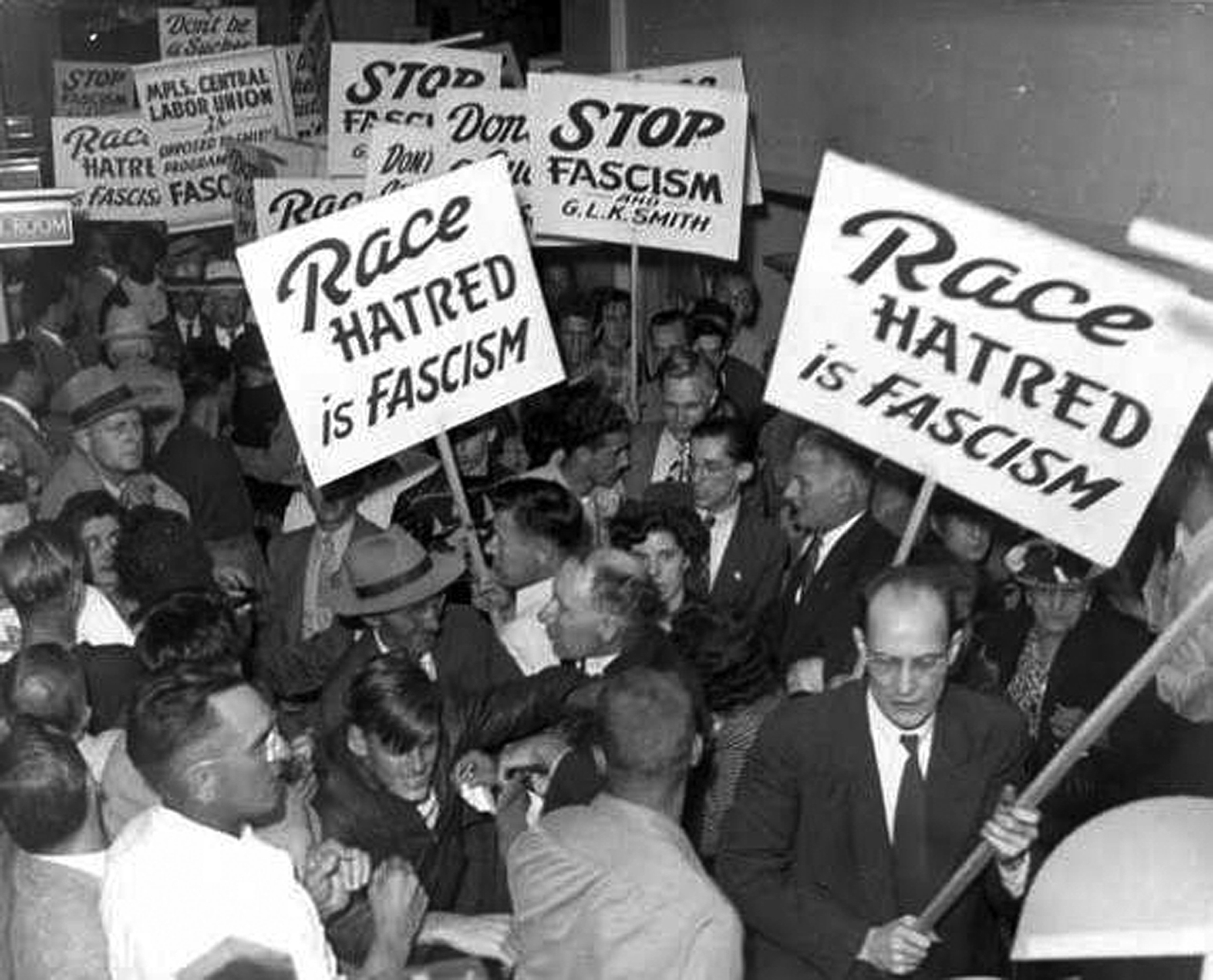“Several videos began popping up around 1:15 p.m. Saturday on social media of about a dozen people, one with a bullhorn, wearing all black with red face masks and carrying black flags with red swastikas on them in the Short North.” The Columbus Dispatch, Nov. 16, 2024.
“A group of people carrying Nazi flags demonstrated outside a community theater performance of “The Diary of Anne Frank” in Livingston County, Michigan, in a display of antisemitism.” CNN, Nov. 12, 2024.
When will the next fascist headline involve Minnesota?
Look at the state history and see that it could likely be soon. Yes, Minnesota, a state known for lakes, welcoming immigrants, Tim Walz and Prince has a long history of fascism.
In 1938, revisionist history books tend to suggest that the moral United States was on the brink of joining the Allies.
The truth is that there was a fascist movement gaining traction across the United States and more than one Minnesotan was at the forefront. Charlies Lindbergh, one native son, was a Nazi sympathizer, advocated isolationism and was vocal in the America First movement.
Another native son, George Deatherage, was chief of the Knights of the White Camelia.
Founded in Louisiana in 1867, this organization was like the KKK but even more flagrant in their intimidation as they did not disguise themselves.
Deatherage focused on the lack of unity among the American Nazis and tried to unite the 800 groups under the military dictatorship of Major General Moseley. A planned coup was discovered and quashed in 1940.
Silver Shirts
“The Silver Shirts, a national organization anti-Semitic and anti-Negro in principle, have been holding meetings in Minnesota.” Minneapolis Spokesman, Aug. 5, 1938.
Only recently freed from the yoke of the Citizens Alliance, a business oligarchy that suppressed unions and controlled the city from 1900-1930, Minneapolis flirted with organized fascism.
In 1939, Silver Shirt recruitment meetings were organized in Minneapolis. William Dudley Pelley, who had founded the Silver Legion of America, popularly known as the Silver Shirts and modeled after Hitler’s brown-shirted street fighters, wanted to recruit 3,000 to 5,000 new members to the Silver Shirts.
He sent his top lieutenant, Roy Zachary, to speak at public rallies and in private meetings. T.G. Wooster, state organizer of the Silver Shirts, assisted in sending invitations to Minnesota businessmen and professionals.
On Aug. 3, 1938, the Duluth Herald shared that 300 people “paid 25 cents each to hear Roy Zachary, national organizer of the Silver Shirts, deliver an anti-Semitic address at Ark Lodge Auditorium.”
Zachary explained that the organization was opposed to Jews and has a “fine-spirited Christian philosophy.” One of his proposals was to segregate all Jews in one city in Minnesota.
One businessman when called out for attending the fascist meeting responded that he went out of curiosity but privately admitted “it wasn't a very comfortable chair, but I could have sat there for two hours more listening to his wonderful message.”
For the September meeting, Pelley himself planned to speak. It never happened.
By this time the 544 Union Defense Guard had organized under Ray Rainbolt. “The requirements to join the UDG were few but important, and they included a willingness to defend all who may be potentially victimized by fascist groups and to take part in the minimal training required to have a reasonably well-organized guard.”
A cab driver alerted Rainbolt where Pelley was. Rainbolt contacted and warned Pelley not to proceed. When the audience arrived at Calhoun Hall, the UDG was there. The audience and Pelley both left.
“Zachary made no further attempts to hold rallies in Minneapolis; fascist propaganda tapered off; and after a time it became evident that the Silver Shirt organizing drive in the city had been discontinued altogether.”
Suppressing Information
One group burned the books. Another banned them. Both have the same effect. One book that the German Nazis certainly would have burned and the far right would ban if they read would be “It Can’t Happen Here.” Sinclair Lewis, a venerable native son, sounded the alarm in 1935.
The New Yorker’s review stated that reading the novel was a public duty. Lewis “knows the fascist leader will not be a fascist leader, but a Professional Common Man who will Attack the Interests — but who, strangely enough, will not be very vigorously attacked by them…His methods will be similar – intimidations, mass propaganda, murder — and his ideas will be similar.” How prescient.
The Southern Poverty Law Center has been tracking the rise of hate groups in the United States.
In 2000, they listed 599 groups nationally with eight in Minnesota. In 2023, the numbers had increased to 1,430 nationally and 22 in Minnesota. If only this increase had been shared more than that of the price of eggs.
Minnesota Firsts in Social Change
Despite this complicated past, Minnesota has led the way in protecting minority groups — the American Indian Movement (1968), law outlawing segregation (1869), first legal same sex marriage in the U.S. (1971).
It’s time for Minnesota to lead the way in making Nazi propaganda a hate crime and therefore not protected as freedom of speech. Germany guarantees freedom of speech but clarifies and criminalizes “disturbing the public peace in a manner that violates the dignity of the victims [of the Nazi regime] by approving of, glorifying, or justifying the National Socialist rule of arbitrary force.”
As of November 2021, New York has banned swastikas and other hate symbols on public property. The Supreme Court needs to revisit the "imminent lawless action" test established in Brandenburg v. Ohio (1969) considering the rise of these empowered hate groups.
As Look magazine stated in 1938, “In a less disturbed world, America could afford to ignore these people as the inevitable fanatic fringe of any free nation. Today they cannot be ignored. Adolf Hitler was once ignored as merely a joke and a fanatic.”






